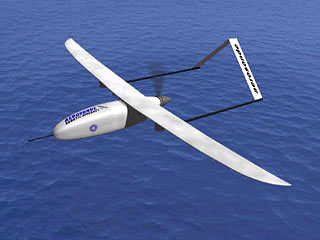
The Aerosonde is a small robotic aircraft for long-range environmental monitoring and surveillance.
The Aerosonde has the potential to fill chronic gaps in the global upper-air sounding network, and to conduct systematic surveillance of tropical cyclones and other severe weather. It is also being adapted for surveillance and other applications requiring lightweight payloads. Miniaturisation and flexibility, fully robotic operation and remote command are the key factors in the Aerosonde success. We have proven that an aircraft weighing less than 15 kg can undertake completely autonomous missions of several thousand kilometres and several days duration. We are now developing the capacity for precision navigation anywhere on the globe and timely communication back to a monitoring site Aerosonde operations combine high performance with the benefits of small size, including low costs, opportunistic basing, and independence of elaborate facilities. Aerosonde development has been underway since 1992, when we proposed the concept in a research paper: Holland, G.J., T. McGeer and H. Youngren, 1992: Autonomous Aerosondes for economical atmospheric soundings anywhere on the globe. Bull. Amer. Met. Soc., 73, 1987-1998. To date we have built and demonstrated the components necessary for long-range autonomous operations. The first Aerosonde (originally designated as a Phase I) was given its full operational trial by the Bureau of Meteorology in early 1998 and passed all objectives. Additional missions have been conducted in Australia, Taiwan, Canada and the United States, including flights in excess of 30 hours endurance, 3000 km range and 5 km altitude, and completely autonomous missions including takeoff and landing. The Phase I aircraft was subsequently renamed as Mark 1 and entered operations in early 1999. This has been updated to the Mark 2 aircraft and a development path has been established through Marks 3 and 4. These aircraft are expected to extend range to beyond 5000 km, and 50 h endurance. Following prototyping support from the US Office of Naval Research, Environmental Systems and Services in Melbourne, Australia developed the Aerosonde, with funding from an Australian R&D syndication. The main subcontracting organisations for this development work were the Insitu Group in the USA and the Australian Bureau of Meteorology. Aerosonde Ltd. and Aerosonde North America Inc. now have the exclusive licence to undertake all Aerosonde operations. They continue with a high profile and active development programme with the Australian Bureau of Meteorology and other organisations. Aerosonde Ltd. and Aerosonde North America Inc. also gratefully acknowledge sponsorship of various components of the Aerosonde development effort You may wish to read a selection of press releases regarding the Aerosonde Program.
|
Return to Aerobotics Index
© Copyright 1999 CTIE - All Rights Reserved - Caution |
